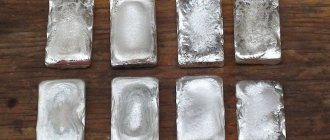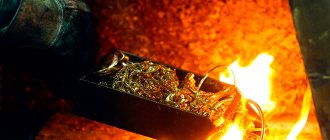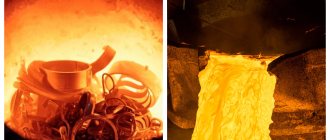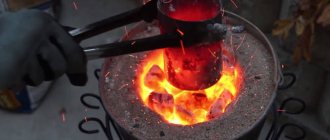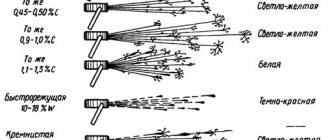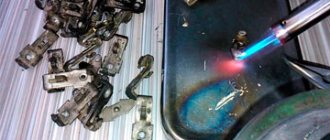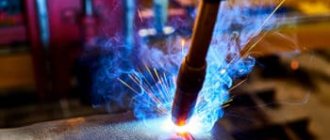Silver is used not only in jewelry, but also in industry, due to the physical and chemical properties of this metal. Therefore, many are interested in such qualities as the melting point of silver, its thermal conductivity and resistance. Silver can be found in microcircuits, resistors, relays, and batteries. This metal is used more often than gold because silver is cheaper and easier to mine.
Cleaning silver jewelry with baking soda
Silver as a metal: physical and chemical properties
The purest silver is a malleable and fusible element that is part of the group of precious metals. This group includes gold, platinum, and five other platinum-class metals.
All noble elements share a unique property - they remain inert when interacting with various air, liquid and gaseous media, leading to corrosion and oxidation. Lunar metal retains its natural shine when exposed to carbon dioxide. Under normal conditions, it reacts with sulfur to form silver sulfide.
In its pure form it is heavy, its density is estimated at 10.5 g/cm3. It is slightly lighter than lead, but heavier than copper. Capable of maintaining geometric dimensions and surface properties when heated, while possessing wide capabilities for changing shape.
Among other things, the precious metal is famous for its disinfecting properties.
Remelted silver bars
Melting and boiling points of silver: main factors
To melt the precious metal, a temperature of 962 °C or 1234.15 kelvin is required.
Boiling point is 2212 °C or 2485.15 kelvin.
This is the point after which a liquid body begins to transition to the gaseous stage.
Why melt silver
Many people do not suspect that precious metal surrounds us everywhere. About 80% of global silver production comes from the industrial sector, with the remainder from banks and jewelry.
Lunar metal is found in radio components, batteries, contacts, capacitors, coins, cutlery, and jewelry. Even the average user's computer or laptop contains about 1 gram of precious metal.
By melting silver, you can create an analogue of a bank ingot or a unique dyeing with your own hands. If you have accumulated a lot of silver items at home that can no longer be useful, you should not rush to throw them away.
Other metal remelting methods
- A significant amount of lunar metal can be smelted using a blowtorch. Accordingly, the work equipment (crucible with charge) will have to be placed in a fireclay clay pipe of larger diameter and wall thickness.
- At home, you can melt silver using an ordinary microwave oven, using a stand made of asbestos or other temperature-resistant material.
- To melt metal, you can use a special melting furnace, which you can purchase or build yourself. It is better to install homemade or factory-made installations separately in a garage or country house.
Fireproof laboratory crucible or asbestos melting mold
Melting silver is impossible without a fireproof vessel or crucible. A crucible is a container for heating, firing, and drying various materials. It usually has a conical or cylindrical shape. The melting mold of asbestos is one of its varieties.
Asbestos is a chemically resistant material that can withstand temperatures up to 1900 °C. If there is no crucible, you can take a spoon and cover it with asbestos sheets, and then with flux.
You can buy a crucible in a store from 100 rubles apiece. Choose those that can withstand temperatures of 1000 degrees. The crucible resource is usually enough for 50 melts.
Before starting work, it is best to place the asbestos under a fireproof container for additional protection. This way you can avoid fire hazards.
Forceps
To work, you need to purchase heat-resistant tongs or tweezers. They are used to grip a crucible to pour the molten precious metal into a prepared mold where it will solidify.
The cost of heat-resistant tools is from 350 rubles.
Melting silver at home
Metal spoon
You can make a mini-smelter from an ordinary spoon by covering it with asbestos sheets. Next, the spoon needs to be coated with flux, which is sodium tetraborate. This is necessary so that the precious metal does not react with air when melting.
Important! Sodium tetraborate is a pharmaceutical borax. It not only prevents oxidation, but also helps the liquid base flow over the sides of the crucible.
Melting charge
A mixture is a mixture of melted metal and borax.
In order for the precious metal to quickly transition from a solid to a fluid state, silver elements are first broken into small pieces. Then they are mixed with borax in a ratio of 10 to 1 part sodium tetraborate.
Pliers
You will need pliers to break the silver elements into smaller pieces. Another tool that is also suitable for this purpose is pliers.
Magnet
Silver alloys are compounds of precious metals with various impurities. To extract particles of iron alloy from the material, you need to use a magnet.
Silver with impurities
If the alloy is not cleaned in this way, then in the future the metal will heat up unevenly, and it will take longer to transition to the liquid state.
Powerful step-down transformer with an output voltage of 25 V
The transformer is used as the main element of the melting device.
Story
Silver has been known to mankind since ancient times. This is due to the fact that at one time silver, like gold, was often found in its native form - it did not have to be smelted from ores. This predetermined the rather significant role of silver in the cultural traditions of various peoples. One of the oldest centers for the extraction and processing of silver was prehistoric Sardinia, where it was known since the early Eneolithic.
In Assyria and Babylon, silver was considered a sacred metal and was a symbol of the Moon. In the Middle Ages, silver and its compounds were very popular among alchemists. Since the middle of the 13th century, silver has become a traditional material for making tableware. In addition, silver is still used to this day for minting commemorative coins (the withdrawal of the last silver coins from circulation in the 1960s and 1970s approximately coincided with the crisis of the Bretton Woods monetary system).
origin of name
Slavic names of metal - Russian. silver, Polish srebro, Bulgarian silver, ancient glory silver - goes back to the Proto-Slavic *sеrebro
, which has correspondences in the Baltic (Lit. sidabras, Old Prussian
sirablan
) and Germanic (Gothic silubr, German Silber, English silver) languages.
Further etymology outside the German-Balto-Slavic circle of languages is unclear, suggesting either a derivation from the same base as Anatolian subau-ro
“brilliant”, or an early borrowing from the languages of the Middle East: cf. Akkadian sarpu "refined silver", from Akkad. sarapu “to purify, to melt,” or from the pre-Indo-European languages of ancient Europe: cf. Basque. zilar.
The Greek name for silver is ἄργυρος, árgyros
comes from the Indo-European root
*H₂erǵó-, *H₂erǵí-
, meaning “white, shining.”
argentum,
comes from the same root .
Melting scrap silver using various devices at home
So how do you melt silver? The algorithm of actions will be approximately the same for any method. The transition from one step to another must be carried out strictly in order.
- First, a melting pot is prepared, which is a crucible or spoon treated with pharmaceutical borax.
- Silver parts are loaded into the smelter.
- Now the materials are heated to a liquid state.
- The resulting liquid filling must be poured into a pre-prepared cast iron mold.
Important! On the eve of the process, it is better to separate the precious metal by degree of purity. Material from different samples will have different combustion temperatures.
Melting silver on a gas burner
Knowing at what temperature silver melts, you can begin the process itself. Home casting involves the following steps:
- Precious metal must have a high degree of purity to work. The ideal option is 999, 960, 925 markings.
- Prepare a crucible from fire-resistant materials.
- Pre-obtain a form for low tide. You can make it yourself or buy it in a specialty store.
- Metal that has been cleaned or broken into small particles can begin to be melted. The burner should be at a distance of 3-5 centimeters from the material.
- After the final transition of the precious metal into a liquid state, it must be poured into the prepared mold. This needs to be done as quickly as possible, but carefully. The base, ready for casting, resembles a drop of mercury. It should remain inside the mold until completely hardened.
- After crystallization of the precious metal, it must be removed from the mold, then placed under a stream of ice water. If the silver does not separate from the mold, after cooling it is removed by hand.
Important! When using the burner, you must carefully monitor the flame. It should be soft so that the flux does not fly apart.
Melting scrap silver
Melting in the microwave
This method is not only safe, but also the fastest. The oven power must be at least 700 W.
Precautions for smelting operations
Foundry processes require increased safety precautions. There should be no flammable substances near the isolated work area. You should not skimp on protective equipment; you should definitely purchase glasses with protective glass on a garter, an apron, gloves, and work clothes.
Clothing must cover the entire body, since even a drop of hot precious metal can burn a section of skin to the bone.
You can also purchase a fire extinguisher to prevent a fire.
Homemade silver smelting
Cleaning silver from impurities yourself
The procedure for removing impurities is called refining. Using refining you can clean:
- Scrap of high-grade precious metal products;
- Technical silver;
- Waste from electrical cleaning;
The refining process should take place in a room with a powerful hood or outside. Substances harmful to humans will be released into the air.
To clean silver from impurities, you can place the material inside a liter jar and fill it halfway with nitric acid. The reaction will be manifested by heat and a pronounced bitter odor.
You will need to wait until the essence has cooled completely. Next, a saline solution is added to the container. As the reaction progresses, the precious metal chloride will settle to the bottom.
Now you need to pour running water into the jar. When the sediment sinks to the bottom again, the surface water layer is drained. The action is repeated several times until the essence becomes completely transparent.
Important! For 100 g of processed material, 250-350 ml of each reagent are needed.
A fairly common cleaning method is electrolysis. This refining is based on the characteristics of a smooth electric current. Silver parts act as the anode, and a silver plate acts as the cathode.
For the electrolysis method you will need:
- DC transformer;
- Clamps;
- Vessel with electrolyte (silver dissolved in nitric acid);
Physiological action
Traces of silver (about 0.02 mg/kg) are found in the bodies of all mammals, but its biological role is not well understood. The human brain is characterized by a high content of silver (0.03 mg per 1000 g of fresh tissue, or 0.002% by weight in the ash). Interestingly, in the isolated nuclei of nerve cells - neurons - there is much more silver (0.08% by weight in the ash).
From the diet, a person receives on average about 0.1 mg of Ag per day. Egg yolk contains relatively much of it (0.2 mg per 100 g). Silver is excreted from the body mainly in feces.
Silver ions have bacteriostatic properties. However, to achieve a bacteriostatic effect, the concentration of silver ions in water must be increased so much that it becomes unfit for drinking. The bacteriostatic properties of silver have been known since ancient times. In the 6th century BC. e. The Persian king Cyrus II the Great used silver vessels to store water in his military campaigns. Covering superficial wounds with silver plates was practiced in ancient Egypt. Purification of large quantities of water, based on the bactericidal effect of silver, is especially convenient to carry out electrochemically.
In the early 1970s, the lower limit of the bacteriostatic effect of silver was estimated to be about 1 μg/L in water. According to 2009 data, the lower limit of action is at the level of 50-300 μg/l, which is already dangerous for humans.
Like all heavy metals, silver is toxic when ingested in excess.
According to US health standards, the silver content in drinking water should not exceed 0.05 mg/l. According to current Russian sanitary standards, silver is classified as a highly hazardous substance (hazard class 2 based on sanitary-toxicological hazard), and the maximum permissible concentration of silver in drinking water is the same 0.05 mg/l.
With prolonged intake of excess doses of silver into the body, argyria develops, which is externally expressed as a gray coloration of the mucous membranes and skin, mainly in illuminated areas of the body, which is caused by the deposition of particles of reduced silver. Any well-being disorders in patients with argyria are not always observed. However, non-medical sources noted that they are not susceptible to infectious diseases.
Silver ions have a genotoxic effect, destroying the integrity of DNA molecules in cells, including causing rearrangements in chromosomes and fragmentation of the latter. In addition, the researchers identified gene damage in sperm.
Category: question-answer
Is it possible to mix silver of different grades for melting?
Expert opinion
Andrey Seleznev
Chemist-technologist, Volgograd
It must be taken into account that different samples will have individual melting points. It is much easier to melt silver of the same purity, because then the metal will react equally to all processes. It is recommended to clean it from the ligature in advance by chemical or electrolysis.
Is it legal to melt silver at home in the kitchen?
Expert opinion
Pribrezhny Gennady Valentinovich
Jeweler 6th category
Activities for processing scrap and waste of precious metals are subject to licensing in accordance with the legislation of the Russian Federation. Illegal mining may result in an administrative fine. Article 15.44 of the Code of Administrative Offenses states: the fine will be one or one and a half times the cost of the materials that are the subject of the offense.
If you try to sell the resulting bullion to buyers, you may face criminal liability.
Which silver sample melts the easiest?
Expert opinion
Pribrezhny Gennady Valentinovich
Jeweler 6th category
The lower the standard of the precious metal, the easier it will melt. For example, the melting point of 925 silver differs from 875 by 130 degrees upward. Of the most common markings, the lowest melting range is 800 - from 780 °C and above.
Can silver be melted down into elegant home decoration?
Expert opinion
Grishanov Mikhail Petrovich
Jeweler, director of the Grishanov and Co. workshop
You can buy or make your own mold for casting simple jewelry, for example, a simple ring or pendant. However, to make filigree items yourself requires not only special skills, but also specialized equipment.
Melting methods
Today, smelting silver at home involves heating methods such as:
- a special melting furnace, which you can buy or create with your own hands, but they must be installed separately from other items, preferably in the garage;
- the most common microwave oven, stove or gas burner;
- There is another method of melting silver products, less popular for home use - a blowtorch.
The outcome of the process of melting silver products at home entirely depends on the complexity of the work. Of course, if a pig of any shape is required, no problems arise. If your idea requires the creation of a beautiful product, it is better to contact a craftsman. Unfortunately, without work experience, it is impossible to create an unusual decorative format for jewelry, especially at home.
